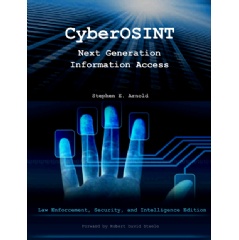Cyber Threats Boost Demand for Next Generation System
The National Cybersecurity and Communications Integration Center responds to increased cyber threats. CyberOSINT: The Essential Technology to Counter Cyber Threats
Cyber threats require next generation information access systems due to proliferating digital attacks. According to Chuck Cohen, lieutenant with a major Midwestern law enforcement agency and adjunct instructor at Indiana University: "This book is an important introduction to cyber tools for open source information. Investigators and practitioners needing an overview of the companies defining this new enterprise software sector will want this monograph."
President Obama’s announcement of a new initiative to combat the deepening threat from cyber attacks adds an important resource to counter cyber threats. The decision reflects the need for additional counter terrorism resources in the wake of the Sony and Anthem security breaches. The new initiative serves both Federal and commercial sectors’ concerns with escalating cyber threats.
The Department of Homeland Security said in a public release: “National Cybersecurity and Communications Integration Center mission is to reduce the likelihood and severity of incidents that may significantly compromise the security and resilience of the Nation’s critical information technology and communications networks.”
For the first time, a clear explanation of the software and systems that perform automated collection and analysis of digital information is available. Stephen E. Arnold’s new book “CyberOSINT: Next Generation Information Access” was written to provide information about advanced information access technology. The new study was published by Beyond Search on January 21, 2015.
The author, Stephen E. Arnold, a former executive at Halliburton Nuclear Services and Booz, Allen & Hamilton, said: “The increase in cyber threats means that next generation systems will play a rapidly increasing part in law enforcement and intelligence activities.”
The monograph explains why next generation information access systems are the logical step beyond keyword search. Also, the book provides the first overview of the architecture of cyber OSINT systems. The monograph provides profiles of more than 20 systems now available to government entities and commercial organizations. The study includes a summary of the year’s research behind the monograph and a glossary of the terms used in cyber OSINT.
In February 2015, Arnold will keynote a conference on CyberOSINT held in the Washington, DC area. Attendance to the conference is by invitation only. Those interested in the a day long discussion of cyber OSINT can write benkent2020 at yahoo dot com to express their interest in the limited access program.
Arnold added: “Using highly-automated systems, governmental entities and corporations can detect and divert cyber attacks and take steps to prevent assaults and apprehend the people that are planning them. Manual methods such as key word searches are inadequate due to the volume of information to be analyzed and the rapid speed with which threats arise.”
Robert David Steele, a former CIA professional and the co-creator of the Marine Corps. intelligence activity said about the new study: “NGIA systems are integrated solutions that blend software and hardware to address very specific needs. Our intelligence, law enforcement, and security professionals need more than brute force keyword search. This report will help clients save hundreds of thousands of dollars.”
Information about the new monograph is available at www.xenky.com/cyberosint.
Stephen E Arnold Background
Stephen E. Arnold began his work career at Halliburton Nuclear Utility Services in 1973. He worked at Booz, Allen & Hamilton until 1981 when he began work on full text information systems. He and his team developed The Point (sold to Lycos) an automatic Web indexing system and Xoom (sold to General Electric) an online video delivery system. In Year 2000 he worked on the initial index of the US government and then his team built the online system for the Threat Open Intelligence Gateway (TOSIG).
Arnold is the author of “The Google Legacy” (2005), “Google Version 2” (2007), and “Google: The Digital Gutenberg” (2009). He contributes monthly columns about online systems to “Information Today” and to “KMWorld”.
He is a Summa cum laude graduate of Bradley University and he has completed work on his PhD at the University of Illinois. His widely read blog is “Beyond Search” at www.arnoldit.com/wordpress. He has worked as an expert witness and has provided advisory services to a wide range of organizations over the last 30 years.
( Press Release Image: https://photos.webwire.com/prmedia/45623/195602/195602-1.jpg )
WebWireID195602
- Contact Information
- Ben Kent
- Public Relations Manager
- Beyond Search
- (1) (502) 533-2452
- benkent2020@yahoo.com
This news content may be integrated into any legitimate news gathering and publishing effort. Linking is permitted.
News Release Distribution and Press Release Distribution Services Provided by WebWire.
